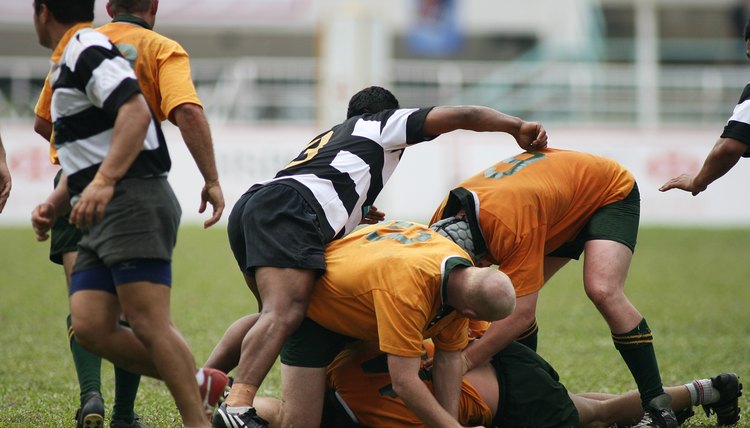Safety in Rugby

People often think of rugby as "football without the pads," but football involves collisions whereas rugby involves contact. In fact, teaching players to make contact safely is a central concept of the sport, says Mathew Brown’s “Rugby for Dummies.”
Tackling
When tackling, the point of contact in rugby is lower than the point of contact in football. The thigh area is the target in rugby, which keeps the ball-carrier’s shoulders and head out of the equation during the tackle. Rugby players also learn to opt for a sure tackle instead of a big collision, which football players often favor. Rugby players must demonstrate proper tackling techniques from their knees, then while walking, then jogging before they’re allowed to advance to making tackles while running, Brown advises. Also, lifting and slamming another player is not allowed, according to the Eastern Pennsylvania Rugby Union.
Hitting
A rugby player is not allowed to hit a player from the other team unless that player is about to receive the ball, is carrying the ball or is directly involved in trying to gain possession of the ball. That means players have a much better idea of when and where any contact will come from than football players do. Football players can hit each other at any time and from many directions.
Gear
Rugby players do not wear full padding and helmets as in football, but players do need studded rugby boots for proper grip and can wear a head guard, shin and shoulder pads, forearm guards, and mouth guards.
Training
Rugby players need to focus on conditioning to avoid injury, according to the website Safe Sport. The majority of injuries in rugby occur during the last third of a match when fatigue sets in. Players need to focus on running stamina and strength, train on wobble boards to boost coordination, use one-leg strengthening moves such as single leg squats, work on sprinting and explosive strength training, and work on hamstring strength and condition. Players need to have both off-season and in-season conditioning.
References
Writer Bio
Linda Tarr Kent is a reporter and editor with more than 20 years experience at Gannett Company Inc., The McClatchy Company, Sound Publishing Inc., Mach Publishing, MomFit The Movement and other companies. Her area of expertise is health and fitness. She is a Bosu fitness and stand-up paddle surfing instructor. Kent holds a bachelor's degree in journalism from Washington State University.
